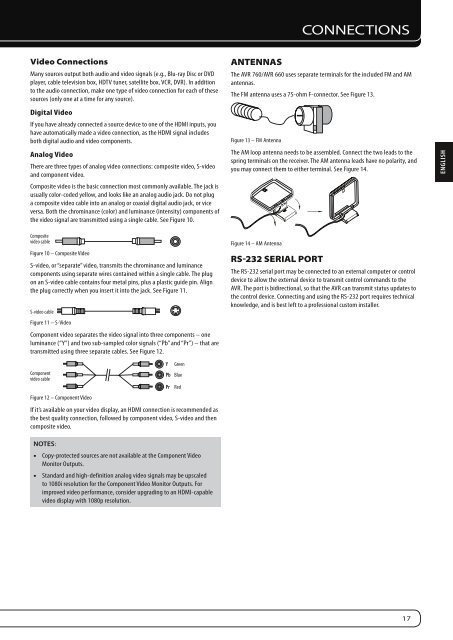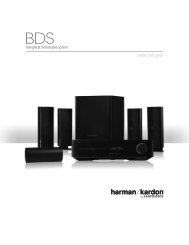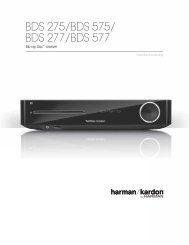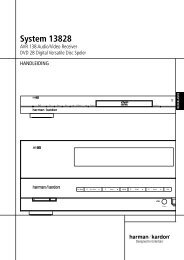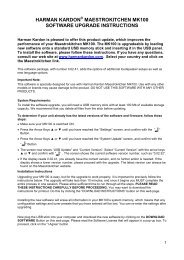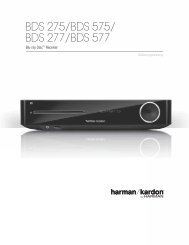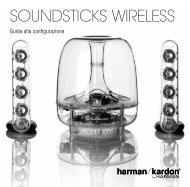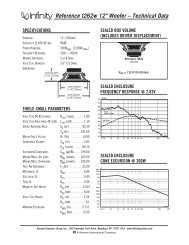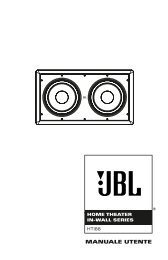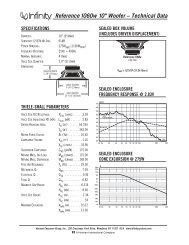Owners Manual - AVR 760, AVR 660 (English EU - Harman Kardon
Owners Manual - AVR 760, AVR 660 (English EU - Harman Kardon
Owners Manual - AVR 760, AVR 660 (English EU - Harman Kardon
You also want an ePaper? Increase the reach of your titles
YUMPU automatically turns print PDFs into web optimized ePapers that Google loves.
Video connections<br />
Many sources output both audio and video signals (e.g., Blu-ray Disc or DVD<br />
player, cable television box, HDTV tuner, satellite box, VCR, DVR). In addition<br />
to the audio connection, make one type of video connection for each of these<br />
sources (only one at a time for any source).<br />
Digital Video<br />
If you have already connected a source device to one of the HDMI inputs, you<br />
have automatically made a video connection, as the HDMI signal includes<br />
both digital audio and video components.<br />
Analog Video<br />
There are three types of analog video connections: composite video, S-video<br />
and component video.<br />
Composite video is the basic connection most commonly available. The jack is<br />
usually color-coded yellow, and looks like an analog audio jack. Do not plug<br />
a composite video cable into an analog or coaxial digital audio jack, or vice<br />
versa. Both the chrominance (color) and luminance (intensity) components of<br />
the video signal are transmitted using a single cable. See Figure 10.<br />
Composite<br />
video cable<br />
Figure 10 – Composite Video<br />
S-video, or “separate” video, transmits the chrominance and luminance<br />
components using separate wires contained within a single cable. The plug<br />
on an S-video cable contains four metal pins, plus a plastic guide pin. Align<br />
the plug correctly when you insert it into the jack. See Figure 11.<br />
S-video cable<br />
Figure 11 – S-Video<br />
Component video separates the video signal into three components – one<br />
luminance (“Y”) and two sub-sampled color signals (“Pb” and “Pr”) – that are<br />
transmitted using three separate cables. See Figure 12.<br />
Component<br />
video cable<br />
Figure 12 – Component Video<br />
Y Green<br />
Pb Blue<br />
Pr Red<br />
If it’s available on your video display, an HDMI connection is recommended as<br />
the best quality connection, followed by component video, S-video and then<br />
composite video.<br />
NOTES:<br />
• Copy-protected sources are not available at the Component Video<br />
Monitor Outputs.<br />
• Standard and high-definition analog video signals may be upscaled<br />
to 1080i resolution for the Component Video Monitor Outputs. For<br />
improved video performance, consider upgrading to an HDMI-capable<br />
video display with 1080p resolution.<br />
antennaS<br />
CONNECTIONS<br />
The <strong>AVR</strong> <strong>760</strong>/<strong>AVR</strong> <strong>660</strong> uses separate terminals for the included FM and AM<br />
antennas.<br />
The FM antenna uses a 75-ohm F-connector. See Figure 13.<br />
Figure 13 – FM Antenna<br />
The AM loop antenna needs to be assembled. Connect the two leads to the<br />
spring terminals on the receiver. The AM antenna leads have no polarity, and<br />
you may connect them to either terminal. See Figure 14.<br />
Figure 14 – AM Antenna<br />
rS-232 SerIaL port<br />
The RS-232 serial port may be connected to an external computer or control<br />
device to allow the external device to transmit control commands to the<br />
<strong>AVR</strong>. The port is bidirectional, so that the <strong>AVR</strong> can transmit status updates to<br />
the control device. Connecting and using the RS-232 port requires technical<br />
knowledge, and is best left to a professional custom installer.<br />
17<br />
ENGLISH


